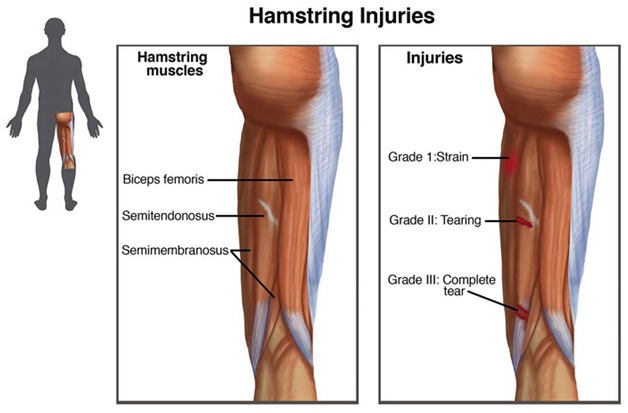Hamstring Injury Causes, Symptoms, Diagnosis and Treatment

What Is Hamstring Injury?
Hamstring injury, also known as a pulled hamstring is defined as an excessive stretch or tear of muscle fiber and related tissues.
Due to the fact that hamstrings experience a complex dynamic process when a person walks or moves, makes it more prone to injuries.
Difficult to treat and rehabilitate, hamstring injury have been estimated to make up of about 29% of all injuries in sprinters.
Because of its reduced moment of knee and hip flexion, biceps femoris long head is thought to be most susceptible to hamstring injury.
The three grades of hamstring injuries are as follows:
- Grade 1
- Characterized by a mild pull
- Grade 2
- Marked by a partial muscle tear
- Grade 3
- Depicted by a complex muscle tear
Healing time for hamstring injury is dependent upon the extent and severity of the injury itself. While a grade1 hamstring injury may take a few days to heal, a grade 3 hamstring injury may take months.
Causes Of Hamstring Injury:
Hamstring injury is caused by excessive stretching of hamstring muscles, which are a group of three muscles which run along the back of the thigh from the hip to below the knee.
Known risk factors may include:
- Previous hamstring injury.
- Increasing age of player.
- Sudden change in direction (acceleration or deceleration).
- Poor flexibility.
- Poor strength.
- Hamstring muscle fatigue.
- Muscle strength imbalance between the quadriceps and hamstrings.
- Inappropriate, inadequate or no warm up.
- Excessive sports participation
Symptoms Of Hamstring Injury:
The major symptom characteristic of hamstring injury is the occurrence of sudden sharp pain in the back of the thigh.
Other symptoms include:
- A popping sensation in the thigh
- Swelling
- Tenderness in the affected area
- Bruising
- Discoloration
- Muscle weakness
- Inability to put weight in the affected leg
Diagnosis Of Hamstring Injury:
Hamstring injury can be diagnosed via:
- Physical examination
- Examining the swelling
- Evaluating the extent of the injury
- Pinpointing the exact location of the injury
- Imaging tests
- X-rays, to check for avulsion fractures
- Ultrasound and MRI, to visualize damaged muscle
Treatment Of Hamstring Injury:
The following treatment is available:
- RICE protocol
- Marked by rest, ice, compression and elevation
- Used to reduce bleeding and damage of muscle
- Using cane or crutches to avoid putting weight on the injured leg
- Physical therapy, to improve flexibility
- Surgery, in severe cases
By : Natural Health News




